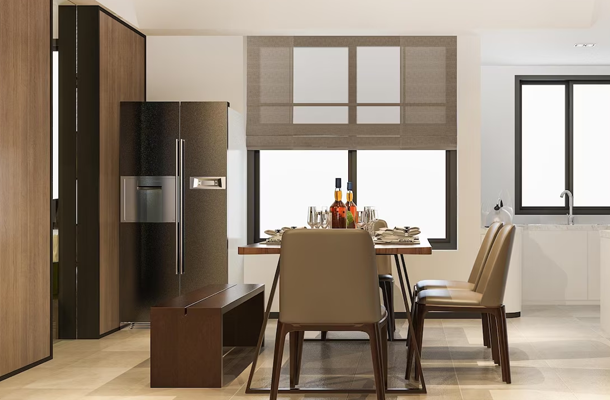Dining Area Designs in Luxury Villas and Apartment homes
Designing the dining area in Luxury Villas and apartment homes involves considering various factors to create a comfortable, functional, and aesthetically pleasing space. Here are some key design considerations for a dining area in apartment homes:
Design Considerations for Luxury Villas and Apartment Homes in Bengaluru, India:
Space Planning:
Layout: Determine the available space and plan the layout accordingly. Consider open layouts, L-shaped configurations, or dedicated dining nooks depending on the overall apartment design.
Traffic Flow: Ensure that there is enough space around the dining table for comfortable movement. Avoid placing the dining area in high-traffic paths.
Furniture Selection:
Table Size: Choose a dining table size that fits the available space and accommodates the number of residents. Consider an extendable table for flexibility.
Seating: Select comfortable dining chairs or benches that complement the table. Upholstered chairs can add comfort, while benches can be space-efficient.
Storage: If space allows, incorporate storage solutions such as a sideboard, buffet, or shelves for tableware, linens, and other dining essentials.
Lighting:
Ambient Lighting: Ensure there is sufficient ambient lighting in the dining area. This could be achieved through overhead fixtures like chandeliers or pendant lights.
Task Lighting: Consider adding task lighting over the dining table, such as a pendant or a set of decorative hanging lights, to illuminate the dining surface during meals.
Color and Style:
Color Scheme: Choose a color scheme that complements the overall theme of the apartment. Consider neutral tones for a timeless look or add pops of color through accessories.
Style: Coordinate the dining area's style with the rest of the apartment. Whether it's modern, traditional, industrial, or eclectic, ensure a cohesive design.
Multifunctionality:
Flexible Furniture: Opt for multifunctional furniture that can serve different purposes. For example, a dining table that can double as a workspace or a foldable table for occasional use.
Open Design: If space is limited, consider an open design that integrates the dining area with the living space, making the overall area feel more expansive.
Accessories and Decor:
Art and Decor: Add artwork, mirrors, or other decorative elements to enhance the visual appeal of the dining area.
Textiles: Introduce textiles such as tablecloths, placemats, or seat cushions to add texture and comfort.
Natural Elements:
Plants: Incorporate indoor plants to bring a touch of nature into the dining area. Plants not only enhance aesthetics but also contribute to a healthier indoor environment.
Acoustic Considerations:
Soft Materials: Consider using soft materials like rugs, curtains, or upholstered chairs to help absorb sound and create a more comfortable dining atmosphere.
Personalization:
Personal Touches: Add personal touches to make the dining area feel like home. This could include family photos, heirlooms, or other items with sentimental value.
Functionality and Comfort:
Ergonomics: Ensure that the furniture is ergonomically designed for comfort during meals. Pay attention to chair height, table height, and overall seating comfort.
Read More
0

